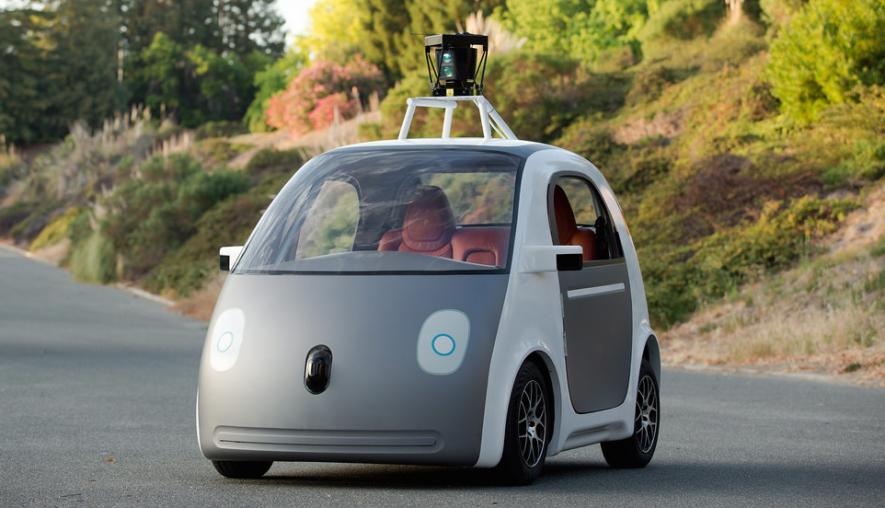Self-driving Vehicles: Coming Soon!

Google Self Driving car. Image Courtesy: https://c2.staticflickr.com/6/5592/15104006386_1bf6bfe96a_b.jpg
There is some or other news almost every day about autonomous vehicles, also popularly known as “driverless” or self-driving cars. Either some or other company is announcing ever-earlier dates when it plans to introduce autonomous vehicles into the market, or some new city or region, usually in the US or Europe, is granting permission for trials of autonomous vehicles. The competition between autonomous vehicles (AV) manufacturers or system designers is getting more intense by the day, as each wants to grab the early-bird advantage, and the technology is maturing rapidly, faster than envisaged even just a few years ago. Regulatory systems are being forced to keep pace, perhaps faster than they would have wished, as pressure from technology providers and potential users is mounting. Trials under actual traffic conditions are taking place in increasing numbers of locations, and the first fatality from a collision involving a self-driven car has also already taken place, albeit one with a driver in the passenger seat as required by almost all regulators!
It is now clear that autonomous vehicles will be seen deployed in traffic in the US and Europe, in cars on designated city roads or in trucks on major highways, sooner than earlier envisaged. This article looks at the technologies involved, their applications and potential users, advantages and constraints under different traffic conditions, and the new regulatory systems likely to come about or that may be required. Lastly the article speculates about the possibility of AVs operating in India.
Technologies and Systems
The first thing readers should know is that autonomous vehicle technology is not a new kind of vehicle or new automotive technology but an intelligent navigation and guidance system that sits on top of vehicles modified for the purpose. Therefore designers of AV systems are usually a different set of people or companies from automobile manufacturers. Indeed, initially efforts at developing AVs were made by automobile companies, but when it soon became apparent that the main issues related to information technology (IT) and artificial intelligence (AI), the tech people started taking the lead.
It may come as a surprise --- or not! --- that considerable prompting for autonomous vehicles came from the US Department of Defence through a competition organized in 2005 under its DARPA (Defence Advanced Research Projects Agency) Urban Challenge and Grand Challenge programmes to develop driverless vehicles that could operate under traffic conditions. The Department of Defence was of course interested in robotic vehicles that could operate on the battlefield without putting its soldiers in harm’s way. DARPA’s Grand Challenge prize of $2 million was won by the robotic vehicle named Stanley developed by a team led by Sebastian Thrun, then heading Stanford University’s Artificial Intelligence Laboratory, and later co-inventor of Google’s famous “Street View,” the mapping software that gives the user a three-dimensional driver’s-eye view of streets obtained through car-mounted cameras, the same basic navigational idea underlying AVs. The Team also had 15 engineers working for Google including Anthony Levandowski who, along with Thrun, played a lead role in later building Google’s self-driving software called “Chauffeur”, and about whom we will hear more later.
Google’s hopes its “Chauffeur” becomes as ubiquitous in AVs as its browsers are on computers or smart phones. In a drive to further push for a dominant position, Google is also one of the few AV system companies with a car of its own design, deliberately designed to look cute and non-threatening and with a maximum speed of 40kmph (see photo) but also mounts its system in other cars customized for self-driving. All Google cars put together have so far accumulated close to 300 million km of autonomous driving mostly in traffic, albeit in selected areas! Elon Musk’s Tesla has also accumulated over 200 million km including the single fatality so far (compared to the US average of 1 fatality per 150 million km).
All AVs primarily use LIDAR (sometimes thought to be an acronym for Light Imaging, Detection and Ranging, but probably derived from a word coined by combining Light and Radar) technology perched atop the vehicle like a beacon light. Typical LIDARs (which work like but are not radar or sonar) use 64 laser beams which scan and form images of the surroundings in three dimensions, superimposing them on available high-resolution digital street view maps. The LIDAR images are super-accurate, taking more than a million measurements per second and generating images with a 1 cm or better resolution. The pre-loaded images provide the system with information on stationary objects such as locations of street lights, telephone or electricity poles etc, while the LIDAR provides details about moving objects around such as other vehicles, pedestrians etc. AVs would also receive information from GPS, other vehicles and from the cloud to facilitate route planning, traffic negotiation and collision avoidance. The rest of the AV system uses all this real-time information and images to navigate while other sub-systems control the steering, signaling, acceleration and braking, and so on. Most AVs on the roads today are required by regulation to have steering wheels and pedals, and indeed a person in the driver’s seat ready and alert to take over as and when required, but commercial models slated for road-use are being designed without any pedals or steering wheels!
As noted above, most regulatory structures at present require a driver to be present and alert, ready to take over operations at any time. This is because AVs are not yet technologically ready to be fully autonomous and because, even if system designers claim they are, regulators and insurance companies would rather not take chances.
As of now, most manufacturers foresee AVs with full auto-pilot features entering service with all regulatory including insurance clearances by 2020 or even 2019. Volkswagen believes AVs will be in the market by 2019, but not necessarily under its own banner. Google expects to have its AVs on the road as early as 2019, but Tesla more modestly says it will have its AV ready by 2019 but it might take another 2-3 years to meet all regulatory requirements, while the app-based taxi firm Uber claims that if Tesla is ready, it plans to put 500,000 AV taxis on the road by 2019! In Europe, car-makers such as Daimler-Benz and Peugeot are also gearing up, along with AI/IT firms such as Thales (famous for its military hardware) and Valeo, while road trials are well underway in different European and UK cities.
Applications
Vehicle and systems makers are upbeat about the advantages of AVs. By relieving the human driver, AVs would render irrelevant factors relating to occupants such as under- or over-age, disability of any form including blindness, intoxication, distractions such as using cell phones etc. It is claimed AVs will reduce road accidents significantly, perhaps by as much as 80% by 2040 by removing the error-prone human factor, and of course by removing the human from the vehicle altogether, as well as save fuel by optimizing distance covered between points and through better driving practices, perhaps also by increasing vehicle occupancy if used for ride-sharing. Some of this might simply be hyperbole and typical advertising-type over-sell, but if even some it is close to correct, AVs could indeed have positive outcomes.
Opinion is still divided, though, on the form or applications AVs are likely to take, both initially and in the longer term. As one commentator puts it, ahead could lie both heaven and hell. Hell would be overuse of personal AVs even, say, sending the family AV for picking up groceries or meals, or substituting children’s bicycle rides or simple errands otherwise accomplished on foot by multiple AV trips. Heaven would be use of AVs more for trucks, buses, car-share taxis, and people doing away with personal vehicles entirely because they could simply summon one on demand!
Some of the good scenario is already beginning to happen with, as already mentioned, Uber and other taxi services merging as potentially huge customers for AVs. Incidentally, Google’s largest single investment (not including acquisitions) so far is $280 million in Uber in anticipation of synergy in an AV world. Google also spent close to $1 billion dollars in outright purchase of Waze, a company with a smart phone app that enables users to share real-time information about the best and shortest routes between points, traffic conditions etc. Waze, with a user-base of over 50 million people in the US, and other such apps today have a huge data-bank based on which trip distances, times and hence fuel usage can be optimized.
Question is what will determine which way car usage will go? Cost could be one, perhaps major, factor. And this is expected to see AV trucks make a significant dent in the market sooner than personal cars.
An AV kit to be fitted on an existing truck with automatic transmission is likely to cost around $30,000 (Rs.20 lakhs) and around the same for cars. This would make the family car very expensive indeed but the cost could be recovered in quick time even by a big-rig truck costing $150,000 (Rs.1 crore). Truck fleets are expected to save huge amounts from route and fuel-use optimization, time-on-road gains from not having to provide for driver lay-over and rest periods and, of course, from not having a driver at all! No wonder Uber recentlyacquired Otto, a company specializing in AV kits for trucks and started by the former Google team led by Anthony Levandowski (here he is again!). Self-driving delivery vans are also likely to disrupt the retail business but only when inner-city roads are made compatible with AVs.
Volvo and Daimler’s Freightliner seem to be leading the race in AV trucks at the moment which are expected to operate on major highways only. With trials already underway in the US and Europe, AV trucks may be seen in operation as soon as the next few years!
Policy and regulation
With any new technology, particularly one that has such disruptive potential, completely re-structured regulation would be required, and is likely to lag behind the technology development itself. This has already been seen with drones, with app-based taxi services and with other disruptive technologies or systems. Autonomous vehicles are no exception. But the problem will also be for policy makers to frame regulations in such a manner as to anticipate future developments in a scenario characterized with rapid technological changes and varied deployment scenarios. For instance, at present, both in Europe and the US, a human must be present in the vehicle, prepared to take over if required, but clearly this cannot be made a permanent rule if true autonomy for vehicles is to be achieved.
As regards the vehicles themselves, the US National Highway Traffic Safety Administration and comparable European regulations have defined vehicle automation as having 5 levels with Level 0 having no automation, Level 1 being one or more driver-assist functions such as braking systems operated by the vehicle once the brake pedal is depressed by the driver, Level 2 having two or more functions of which the driver is relieved, such as lane centering and cruise control, Level 3 having self-driving automation (like the Google self-driving car) but where the driver should be alert and ready to take over if and when required, and Level 4 being fully autonomous where no driver is required at all, including occupied and unoccupied vehicles.
Issues of liability loom large and insurance companies as well as legal experts are sweating over the complex issues involved. In case of accidents or injuries, who is to be held liable: the vehicle owner, the vehicle manufacturer, or the software company? In the one fatality case, the car could not distinguish between the white colour of the truck ahead and the clear sky, and simply ran under the truck crushing the car’s occupant! “Driver” error or software glitch?
Related ethical issues are also likely to present themselves, familiar to science fiction readers in relation to robots or computers. If a driverless car knows it cannot avoid a collision with either another car or with a cyclist, which option does it choose? In automatic vehicle-to-vehicle information exchanges, how are privacy issues to be dealt with? Some of these questions could be tackled by better and more thoughtful software, and built in to regulations, but some issues are likely to remain ethical dilemmas.
Lastly, how likely are we to see self-driving trucks or cars in India, and when? Purely speculatively, that day is far off. There is just too much chaos on Indian roads. AVs work best under disciplined road conditions, where other vehicles and persons behave in predictable ways. A truck programmed to stay in the left-most lane and not change lanes, would not get very far in India, and over-cautious self-driving cars would likely provoke road rage from cars behind blowing their horns violently, a “signal” something incomprehensible to AVs. The enormous variety of vehicle types along with cycles, animal-drawn carts and pedestrians on the roads is also likely to completely overwhelm AVs which would also not recognize the numerous non-auditory signals and unintelligible manual signaling and waving of arms so characteristic of Indian traffic conditions. Self-driving software can of course be customized for different conditions but, most probably, Indian road traffic and the Indian driver would have to change substantially before driverless cars can operate in India!
Disclaimer: The views expressed here are the author's personal views, and do not necessarily represent the views of Newsclick
Get the latest reports & analysis with people's perspective on Protests, movements & deep analytical videos, discussions of the current affairs in your Telegram app. Subscribe to NewsClick's Telegram channel & get Real-Time updates on stories, as they get published on our website.
























